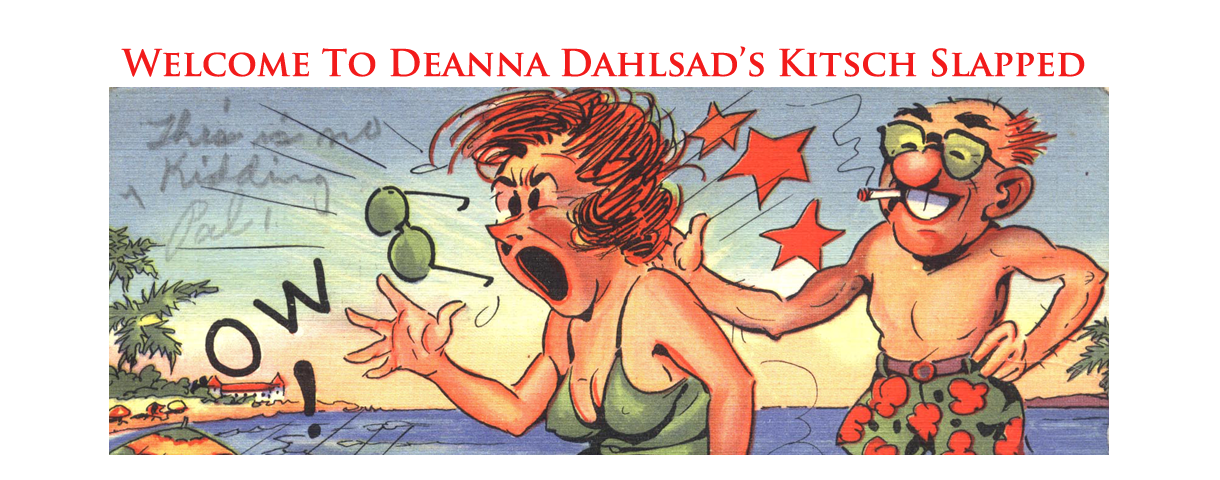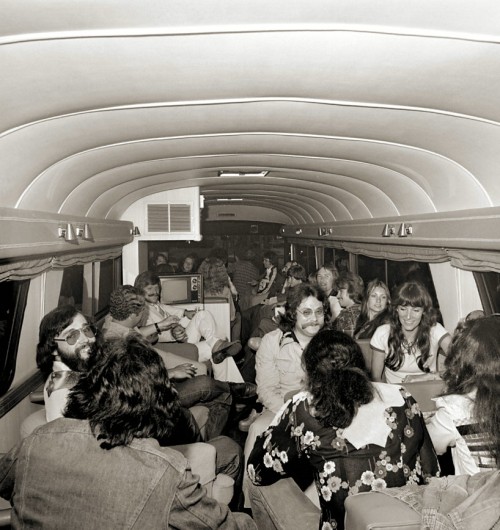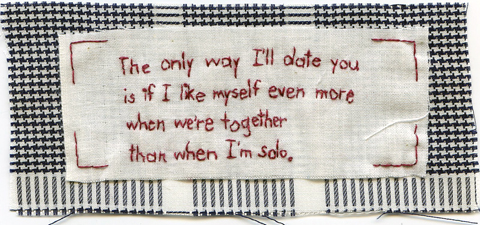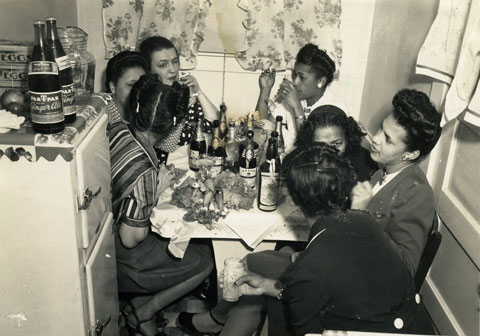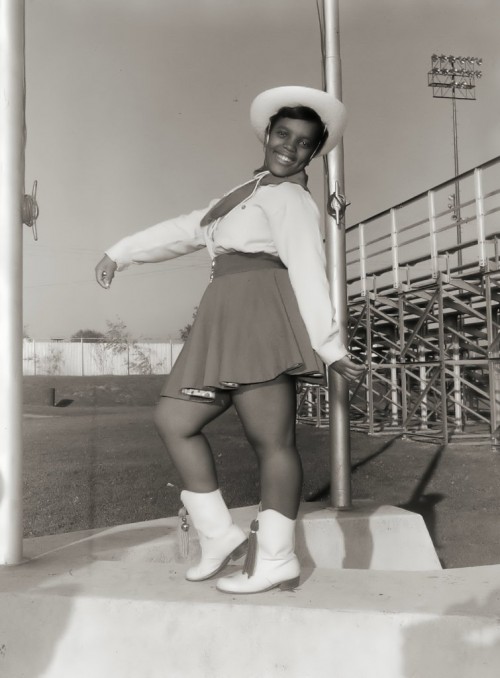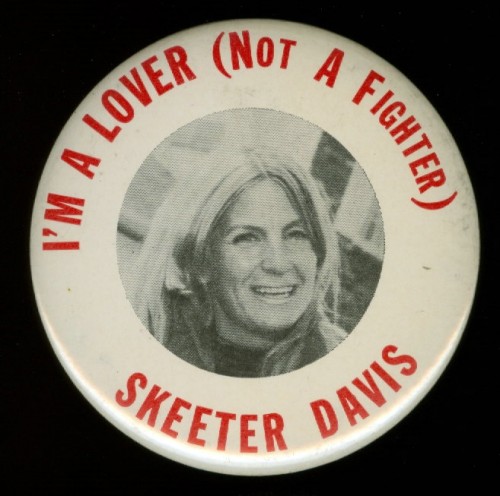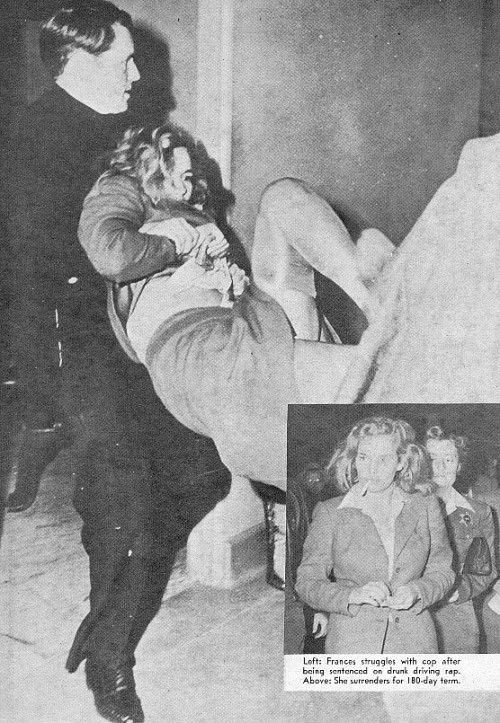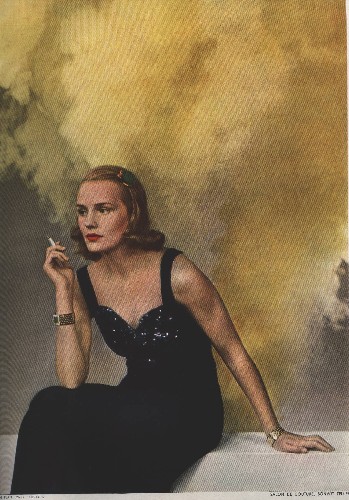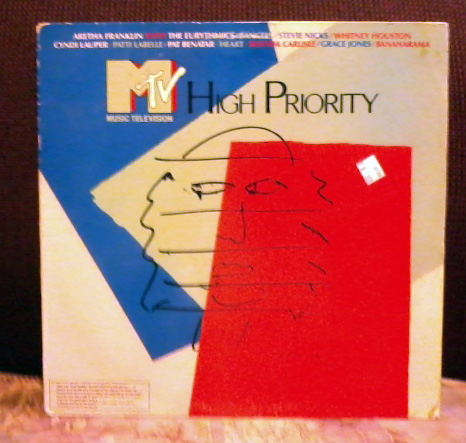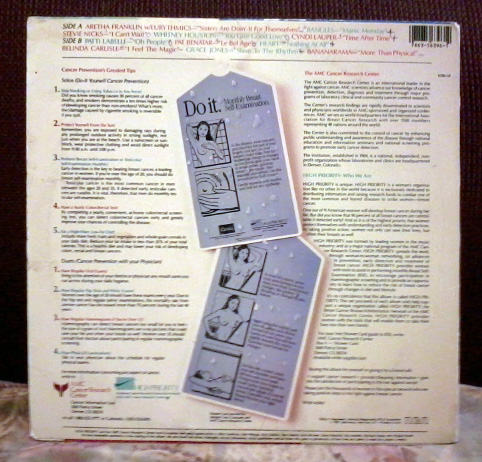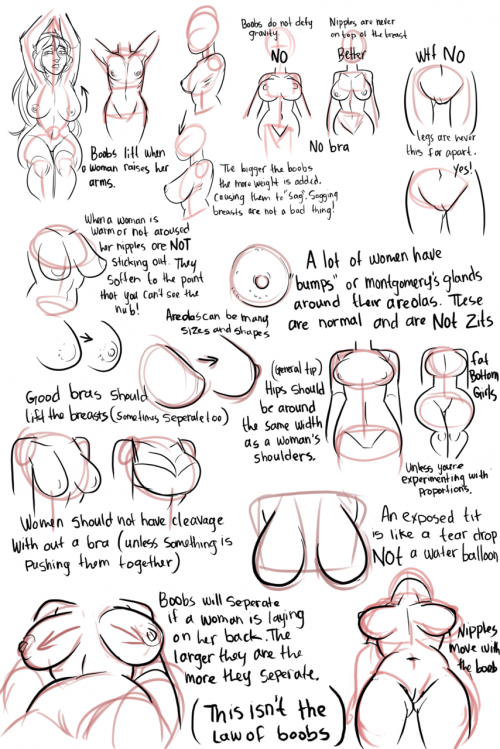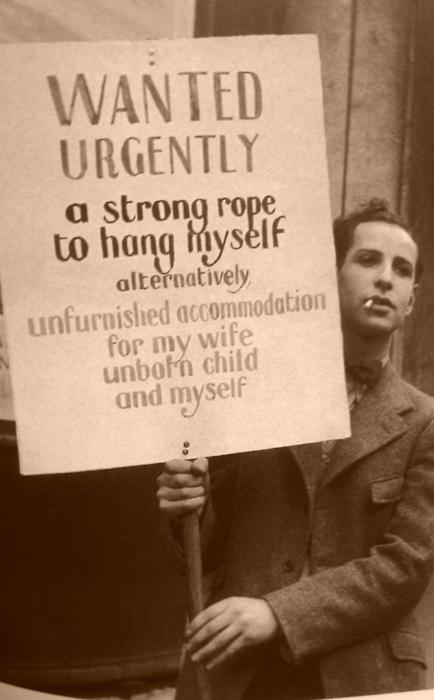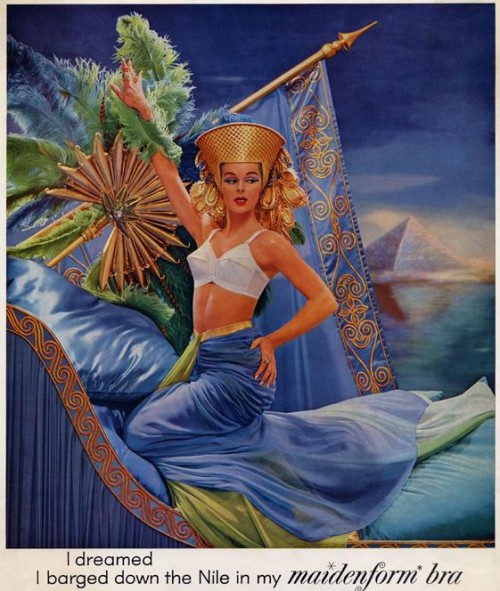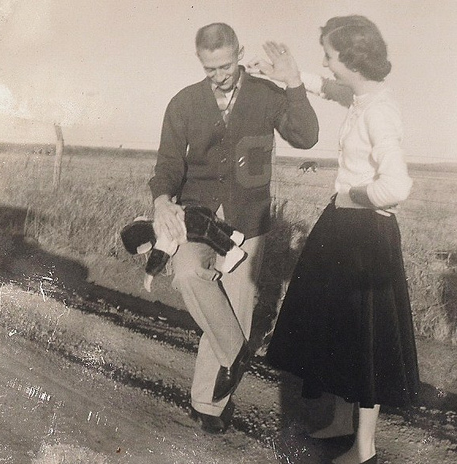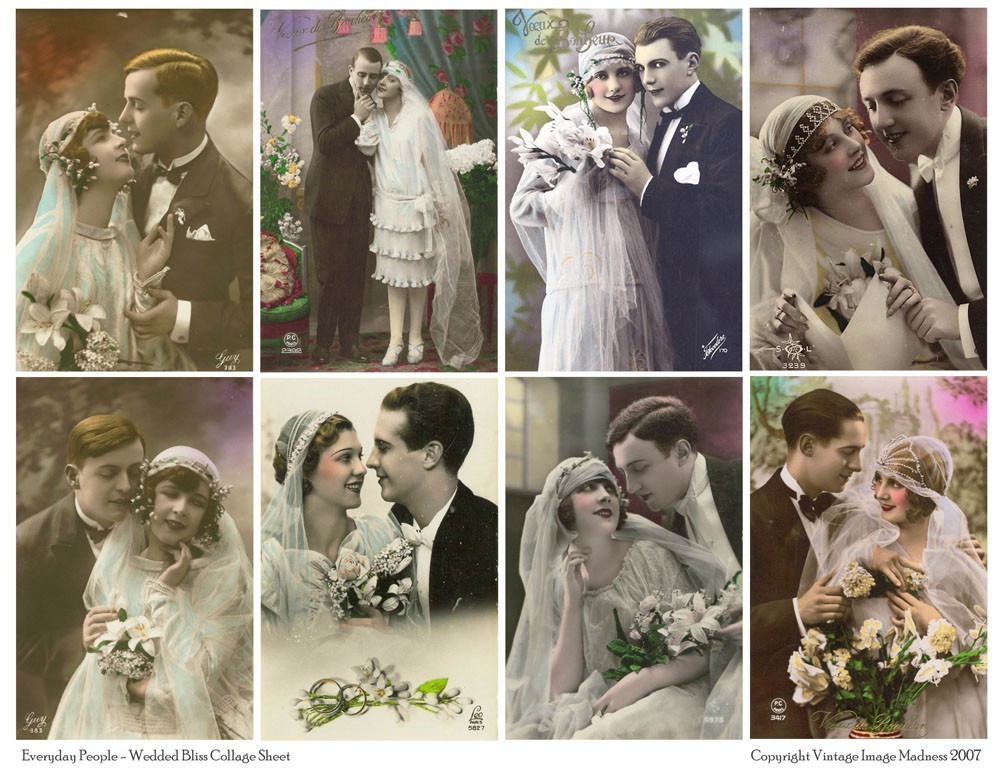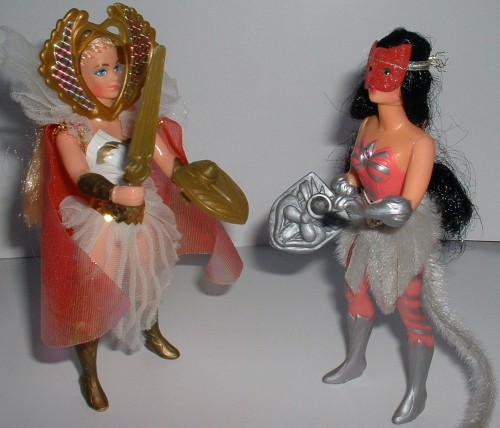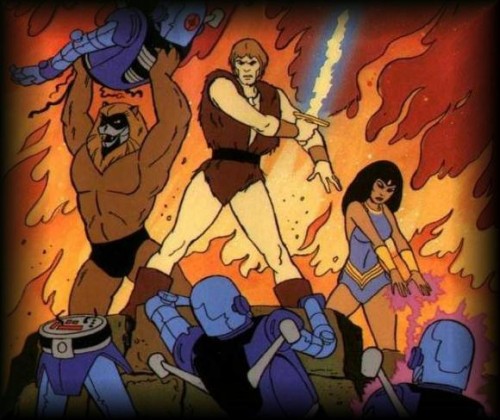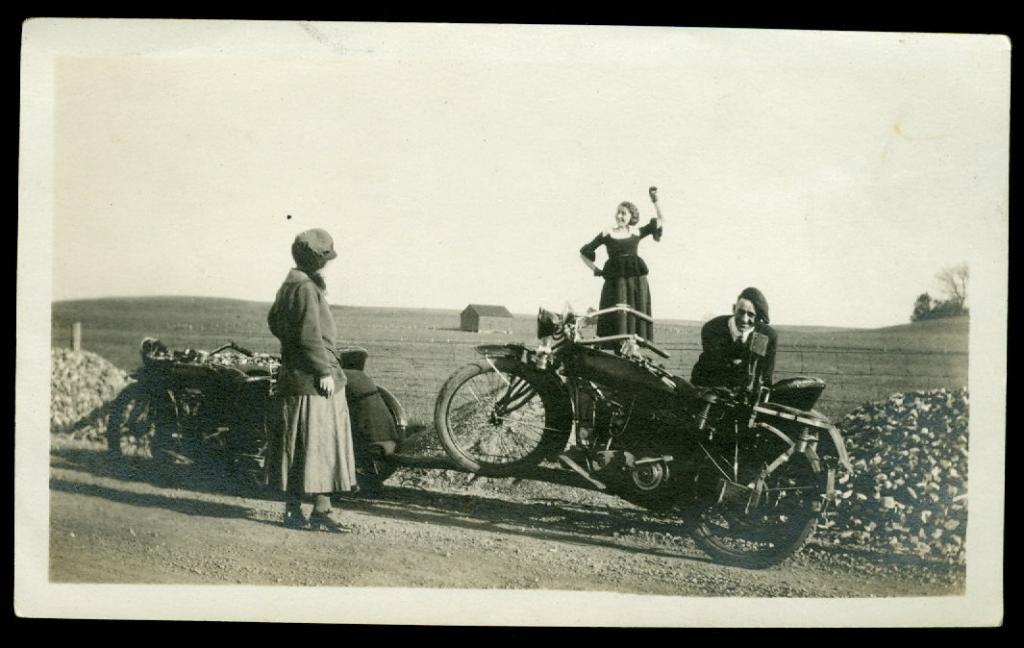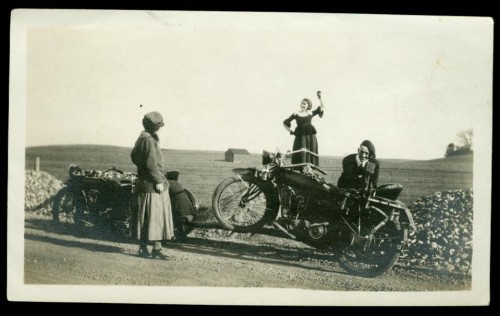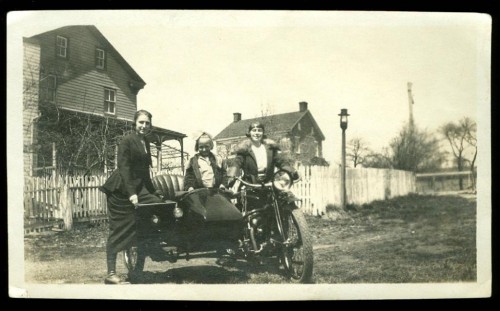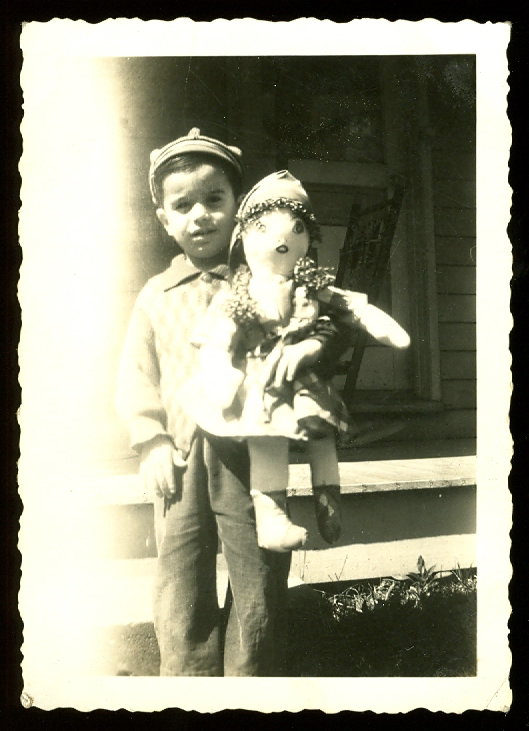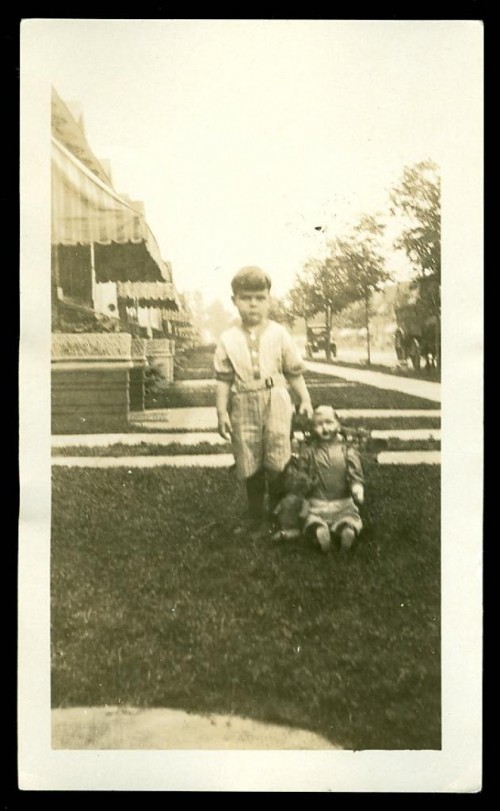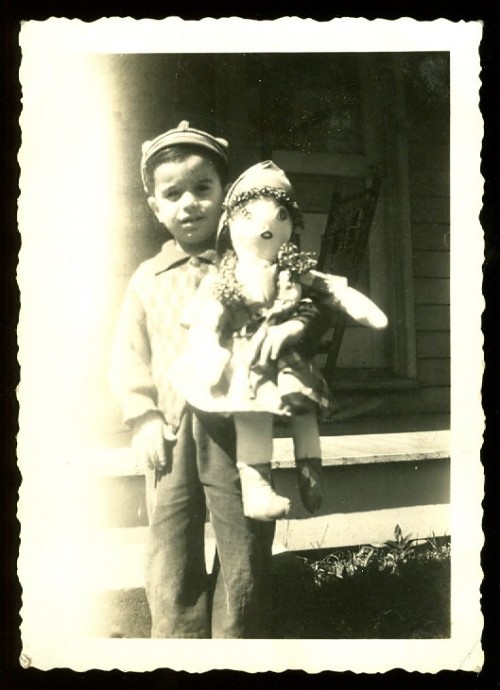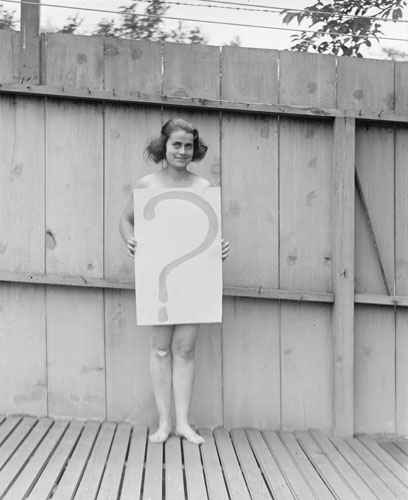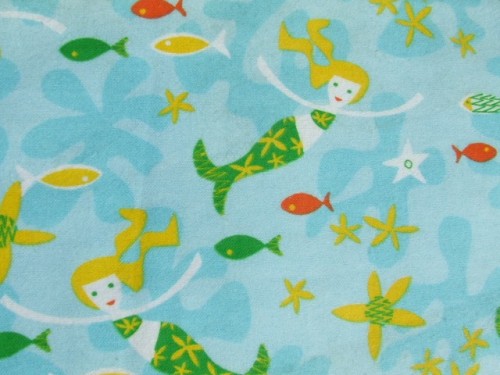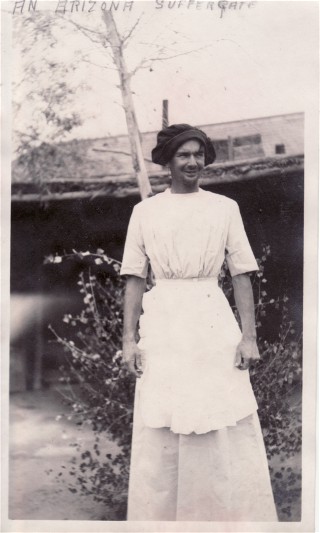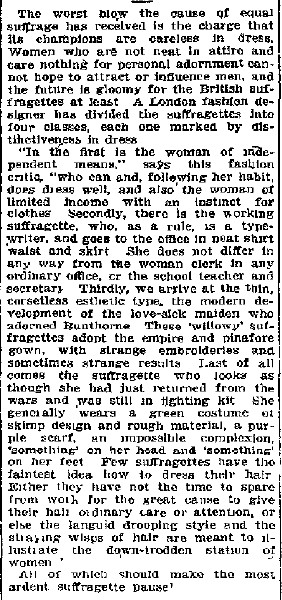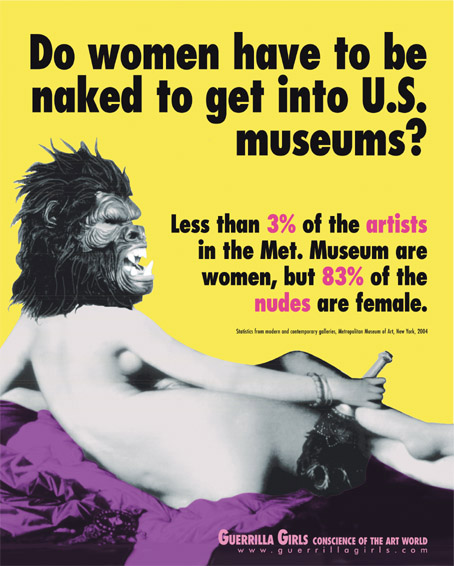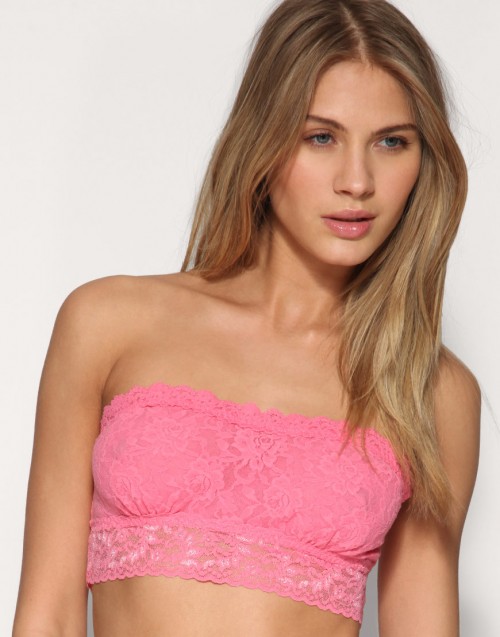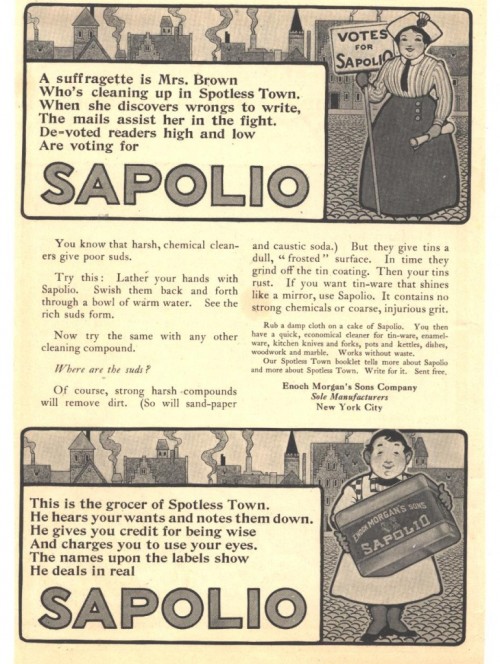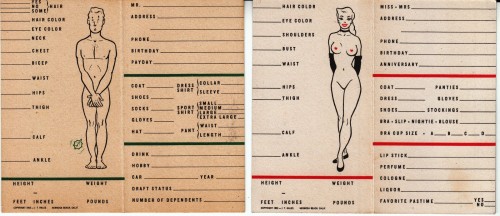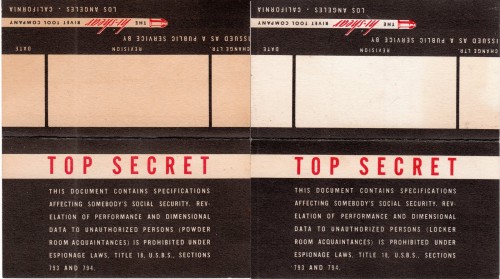In describing this retro image from the 70s, the seller refers to all the women on the band’s bus as “groupies.” The seller isn’t comfortable stating who the band is, but they are comfortable enough to label the women.
The Only Way I’ll Date You…
Words to stitch and live by. Via.
Share & Share Alike: Why Posting Your “Junk” Is Worthy Of Your Time
In 2010, I was a presenter at the first Bookmark Collectors Virtual Convention, encouraging collectors not to be embarrassed about their collections (bookmarks or otherwise). And recently I discussed how I believe collectibles can — and ought to be — used to teach. Today I present an incredible example of the marriage between two these concepts.
In 2008, author Midori Snyder posted a photograph from the 1940s of her maternal grandmother at a crowded kitchen table, drinking and smoking with friends:
It was a cute, rather sentimental post, not only laden with nostalgia but whispering of stories and potential stories; charming, but nothing earth-shattering. Then, in June of this year, something happened…
On June 8, 2011, Snyder posted an update involving that vintage photograph. Snyder received an email from a middle school English teacher who’d been teaching poetry to sixth graders. This teacher was trying to move the students past the “misconception that all poetry is cryptic and impenetrable by nature,” including the use of photographs as inspiration, instructing the students to “bring in a picture to which they are emotionally connected in some way.” Knowing the err, limitations and penchants of students, the teacher had gone to the Internet in search of photographs for students who failed to bring their own in. Along the way, she had found Snyder’s photo. That photo became the “back up” photograph so that students could continue their classwork.
That was the moment of intersection between the teacher and Snyder.
This would be cool enough on it’s own. But what’s cooler than that, was the intersection between Snyder’s grandmother and her adult gal pals from the 1940s and 11 to 12 year old kids in school — and how that fictional “what if” emotional connection bridged a gap to inscrutable poetry. In the teacher’s words:
We wrote. I wrote one too, alongside them. We read them, we clapped, we nodded our heads, we listened. The purpose of this email is to let you know that the act of putting that picture out there changed some of us. It helped us look deeper. It forced us to connect. It made us listen to each other and see things the way we wouldtn’ve on our own, perhaps.
If Snyder had been too “embarrassed” or otherwise dismissed the idea of sharing such a little thing as an old family photograph (and some thoughts about it to assist searches), this magic may not have happened. Yes, the teacher is to be applauded; I make no mistake about that! But she and others like her would have lots less to choose from if the rest of us didn’t offer up our photographs, scans, images, etc.
This time is was a school teacher. And one who took the time to inform Snyder how great her act of sharing was; no small thing to those of us who do share. But every day, lots of other intersections and connections are made from the bits of “stuff” and pieces of “junk” that everyday folks and collectors share. These images and objects help connect students to literature, journalists to stories, researchers to proof, collectors to information, people to memories, individuals to their ancestors in family trees, nerds to history… People connect for the first time to abstract theories. People rediscover individual intimate connections. People reclaim the past, work toward a future. People find answers; people like me find more questions… Heck, people even just find more objects and photographs they must have (often in pursuit of much loftier things than materialistic motives).
The moral of the story is this: No matter what you have, no matter how big or small, how Big Picture or insignificant you think it is — someone is just waiting to see it, learn from it, remember it, be inspired by it.
PS You can read one of the student’s poems at Snyder’s post.
Crunk, Talking Genitals & Childish Fashion Crimes (or, A What I’ve Been Reading Link Round-Up)
Just a good old fashioned link round-up — yee-haw!
1.) At The Crunk Feminist Collective, a thought provoking post on self care for the feminist or liberal activist:
Talk about crunk. Bambara gives the side eye to the notion that you can attack capitalism, racism, or other systems of dominance out in the world without challenging those same systems (especially hetero-patriarchy) within one’s own relationships. That, in fact, leaving your own house “out of order” not only jeopardizes but it, in fact, undermines both your potential for good work and your potential for intimacy and happiness. Indeed, for me, Bambara’s call for us to essentially get our ish together charges us to recognize how important—how revolutionary—it is for us to love (and love on) each other and ourselves fiercely and fearlessly.
I started a group for just this sort of thing at Bliss Connect. It’s called Seeking Progressive Social Bliss; so far it’s a circle of one. *sigh*
2.) I was meaning to write about the horrible Summer’s Eve “Hail To The V” Campaign, but then Stephen Colbert did this:
| The Colbert Report | Mon – Thurs 11:30pm / 10:30c | |||
| Vaginal Puppeteering vs. D**k Scrub | ||||
|
||||
I felt nothing could really top that. (Especially as I have a thing for puppets. Really!) However, I highly recommend this post about the hideous ad campaign at Sociological Images. It’s especially good to show those who don’t understand satire; it’s a mental illness, you know.
3.) As I’ve oft complained about the sexualization of children, especially when it comes to clothing (NWS), I found this bit of fashion news across the pond fascinating:
The review, conducted by Reg Bailey, chief executive of the Mothers Union, was published in June. Bailey’s report, ‘Letting Children be Children,’ looked at cultural influences on children and children as consumers but particularly significant for the clothing sector was its examination of clothing, products and services for children.
The report stated that the marketing of “sexualised and gender-stereotyped clothing, products and services” for children were “the biggest areas of concern for parents and many non-commercial organisations contributing to the review.”
[sic]
As the report was published, the British Retail Consortium (BRC) unveiled a set of guidelines governing the design, commissioning and marketing of clothing ranges for children under 12 years old.
The article continues to discuss the practical and impractical issues involved. As citizen of the USA, I’m left wondering if such clothing prohibition is the answer. After all, the problem isn’t the garments glutting the market; it’s the consumers with horrible judgement who pay for clothing in such poor taste. At what point does the law need to protect us from our bad choices? Or, more pointedly, at what point does the government need to protect children from the bad choices of their parents?
Image Credits: Via eBay. (You’d have already seen it if you visited my Tumblr.
Cheap Thrills Thursday: Skeeter Davis Was A Lover (Not A Fighter)
Skeeter Davis fan club pinback, circa 1970s, printed with her photo and one of her song titles, I’m A Lover (Not A Fighter)
.
Here are the song lyrics:
I only married you for love dear I didn’t go for all of your dough
Now and then you say you love me but honey baby it didn’t show
I never seemed to please you lately cause all you ever do is complain
I’m sick of this fussin’ and fightin’ so baby let your loving woman explain.I’m a lover not a fighter
I kinda like it that way
If you want a fightin’ partner
Go live with Cassius Clay.— Instrumental —
A woman is soft and tender and willing to love her man
So why don’t you take advantage of the woman that you know I am
I don’t want to fuss and fight dear for the rest of my natural life
Stop treatin’ me like your enemy start treatin’ me like a wife.I’m a lover not a fighter
I kinda like it that way
If you want a fightin’ partner
Go live with Cassius Clay.I’m a lover not a fighter
I kinda like it that way
If you want a fightin’ partner
Go live with Cassius Clay.I’m a lover not a fighter
I kinda like it that way
If you want a fightin’ partner
Go live with Cassius Clay…
Resist, And You Are Called Confrontational. Or Mentally Ill.
Remember the Nirvana song Frances Farmer Will Have Her Revenge On Seattle?
Here’s Kurt Cobain’s response to, “So why was Frances Farmer such an inspiration?” (Melody Maker, August 28th, 1993)
“Well, you know, I’d read some books about her and I found her story interesting. She was a very confrontational person.”
Extremely confrontational.
Selfish, maybe. “That’s not what I got from the books I read. Actually, I did from two of the biographies I read about her, but there was one, ‘Shadowland’, the best one, written by this PI from Seattle who researched it for years, and I didn’t get that impression from that one. She was obviously a difficult person, and got more and more difficult as the years went on, as people started to fuck with her more and more.
“I mean, she was institutionalised numerous times and, in the place in Washington where she ended up, the custodians had people lining up all the way through the halls, waiting to rape her. She’d been beaten up and brutally raped for years, every day. She didn’t even have clothes most of the time.
“Courtney especially could relate to Frances Farmer. I made the comparison between the two. When I was reading the book, I realised that this could very well happen to Courtney if things kept going on. There’s only so much a person can take, you know?
“I’ve been told by doctors and psychiatrists that public humiliation is one of the most extreme and hardest things to heal yourself from. It’s as bad as being brutally raped, or witnessing one of your parents murdered in front of your eyes or something like that. It just goes on and on, it grinds into you and it’s so personal.
“And the Frances Farmer thing was a massive conspiracy involving the bourgeois and powerful people in Seattle, especially this one judge who still lives in Seattle to this day. He led this crusade to so humiliate her that she would go insane. In the beginning, she was hospitalised – totally against her will – and she wasn’t even crazy. She got picked up on a drunk driving charge and got committed you know. It was a very scary time to be confrontational.”
Though nothing could excuse what was done to her, even the most reverent accounts of Farmer’s life don’t attempt to deny that she was on extremely difficult person, that her much-vaunted independence often amounted to a ruthless self-interest that left her indifferent to the suffering she caused. So she was no martyr.
But Farmer – beautiful, arrogant, creative, destructive and destroyed –does appear impossibly glamorous, especially from the safe distance of a few decades.
Is that what drew you to her?
“No. No, not at all”
The song, especially if Geffen have the good sense to release it as a single, may succeed in glamorising her.
How would you feel about that?
“I’d feel bad about that. I just simply wanted to remind people of tragedies like that. It’s very real and it can happen. People can be driven insane, they can be given lobotomies and be committed and be put in jails for no reason. I mean, from being this glamorous, talented, well-respected movie star, she ended up being given a lobotomy and working in a Four Seasons restaurant.
“And she hated the Hollywood scene, too, and was very vocal about it, so those people were involved in the conspiracy, too. I just wanted to remind people that it happened and it has happened forever.”
Most of your songs are, in one way or another, about suffering. A popular liberal notion is that suffering ennobles. Do you think there’s any truth to that?
“It can, it can. I think a small amount of suffering is healthy. It makes your character stronger.”
Do you think you’ve suffered on a large or small scale?
“What do you think I think?”
Don’t know.
“I’ve suffered on a large scale but most of the attacks haven’t been on me, they’ve been on someone I’m totally in love with, my best fucking friend is being completely fucking crucified every two months, if not more. I read a negative article about her every two months.”
Why read it? Why torture yourself?
“A lot of the time I can’t escape it because Courtney gets faxes of articles from the publicist all the time. But also it’s a form of protection. It enables you to remember … and to make sure you never deal with those people again. And another reason we like to read it is that we can learn from the criticism, too. If I never read any of the interviews I did, I’d never be able to say ‘Jeez, that was a pretty stupid thing to say. I’d better try to clear that up.’”
I was first introduced to Frances Farmer — and subsequently fell in love with both her and Jessica Lange — in Frances (1982).
The book Cobain “recommends,” Shadowland, by William Arnold, and the ensuing (no pun intended as Arnold sued regarding the film) Lange movie may not be reliable, according to journalist and researcher Jeffrey Kauffman who has spent decades unraveling the Frances Farmer story. However, this doesn’t change much for me.
It’s not that I refuse to accept fact or Kauffman’s research; quite the contrary. I find all the representations and misrepresentations as detrimental to Farmer as the life she did lead. Mental health, especially then, was not kind, no matter what the ignorant intention. The media has only become worse. Her life as a creative, passionate woman was painful, co-opted.
MTV Cared About Your Breasts
Over a decade before Rethink Breast Cancer & MTV News Canada launched (to public outcry; video), and the Women Rock! Girls & Guitars breast cancer benefit too, MTV had the High Priority campaign against breast cancer. (You can be cynical, and view MTV’s interest as self-interest — be it sexist preservation of the sweater-puppets which jiggled in videos, or a way to combat judgement that rock videos and music television would be the end of civilization, but whatever MTV’s motives, they’re active in PSAs.) The campaign began in 1984, but my thrift store find is the 1987 High Priority album.
(I say “find” because up until spotting for $1 at a thrift shop I was ignorant of this MTV effort. In my defense, we didn’t have cable; our family only managed to get a color TV in the late 70s or early 80s — but we were the first to have a microwave oven. My parents only got a video player after I moved out; and they just got cable two or three years ago. So that tells you something about our family values. And why, even if we had cable, I would have likely opted to read anyway instead.)
The profits from this album went to the AMC Cancer Research Center. The album cover featured unfinished, yet signed, art by Andy Warhol on the front; monthly self breast exam info and other cancer prevention tips on the back; and ten songs from leading female performing artists of the time:
Side One
Sisters Are Doin’ It For Themselves; Aretha Franklin with The Eurythmics
Manic Monday; Bangles
I Can’t Wait; Stevie Nicks
You Give Good Love; Whitney Houston
Time After Time; Cyndi Lauper
Side Two
Oh People; Patti Labelle
Le Bel Age; Pat Benatar
Nothing At All; Heart
I Feel The Magic; Belinda Carlisle
Slave To The Rhythm; Grace Jones
More Than Physical; Bananarama
While the High Priority Campaign holds no “remember when” significance, the songs and artists do. So I’m lovin’ listening to it. Grrl power!!
Want it? Infrequently posted on eBay; less expensive at Amazon
.
The Breast Drawing Advice: How To Draw Boobs Without Being A Boob
We all know comic book art, pinups, and many other art forms exaggerate the human form; especially the female form. However, if you want any sort of realism at all — let alone to avoid complaints about body image, statements that comic book nerds have never seen nude chicks, etc. — check out this illustrated tutorial by Ovens (aka Unconventional oven), of Effort Comics (18+ webcomic):
In case you don’t have a pair of your own, haven’t ever seen naked boobs before, or simply forget about physics, this is an excellent reminder. It also pleases me as it points out that our female finer points move, are affected by position & gravity, may not point at all, and may even sag — all of which is natural and beautiful.
I say, exaggerate away, artists, as long as you get the most simple basics of flesh and physics right.
See also: The seventh in the I Draw the Line series by Tom Nguyen. (Sadly, this archive of the series is sans illustrations.) In his “how to draw boobs” entry, Nguyen provides the ultimate artistic breast advice:
Boobs have a general shape, yes, but keep in mind that they are soft and have weight. Therefore, their shape changes to work with gravity and clothing.
Sign Of The Times 1932
Dreaming Of Denial
Cheap Thrills Thursday: Spanking The Monkey
Because people do kinky things to stuffed animals. Via.
Happily Ever After?
In Wedded Blisters, Neely wonders if marriage is something she even wants to enter into. With the media, as she writes, “depicting marriage as this energy-sapping, miserable way of life, where husbands have to practically beg their wives for sex and wives feel like they’re not being validated enough by their husbands” she’s not enthusiastic:
But what about this daily bombardment of television shows and movies, depicting marriage as the root of all evil? The truth is that these comedies and films play off of real life, and we know this to be the case because we laugh at their humor. We laugh because we recognize truth. People love shows like Everybody Loves Raymond because a depiction of an average guy dealing with the daily struggles of marriage is true to the way it is outside of that rectangular, silver screen. Unmarried couples may not entirely relate to the humor but they understand that this is what they’ll eventually encounter once they walk down the aisle. Are we destined for the same path as Ed and Peggy Bundy, we wonder.
So we turn off our televisions, looking elsewhere for signs of encouragement, only to be bombarded by another reality check on the state of marriage today: the nation’s divorce rate, which towers over us at all times, giving us very good reason to doubt that we will escape the odds.
The media’s reflection of our marital problems may be exaggerated ~ but as Neely points out, it’s funny because it’s true. Marriage is a tricky thing, and certainly our libidos aren’t magically put in sync just because we live together. But if I were to look at our media for answers regarding how we’ve got to this place where Ed and Peggy Bundy are more typical than representative of our greatest fears, I’d say the problem lies with the fantasy of marriage.
From early on we are fed fantasies wherein once love is found they ride off into the sunset. If the story is supposed to be saying “and they lived happily ever after,” they never show it. In film, finding one’s mate is the end of the story when in truth it should be just the beginning.
While we often are entertained by (and feed-off of) the drama of ‘the chase’ and the obstacles faced in the pursuit, we forget that ‘ever after’ is a story complete with dramas of its own. There are obstacles, chases and pursuits to be found in every marriage and I think we should thank our lucky stars for that ~ for each one is a chance to reaffirm our love and dedication.
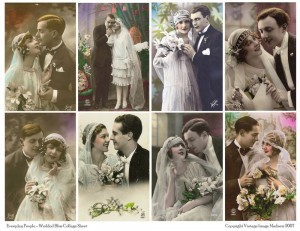 In the romantic movies, our heroes and heroines do not crumple at the first (or even the 10th) problem presented ~ instead they keep their eye on the prize and fight for the chance at true love. Shouldn’t we view and pursue our marriages with the same ardor, passion and dedication?
In the romantic movies, our heroes and heroines do not crumple at the first (or even the 10th) problem presented ~ instead they keep their eye on the prize and fight for the chance at true love. Shouldn’t we view and pursue our marriages with the same ardor, passion and dedication?
Work, bills, children, household chores ~ surely none of these is as difficult as the matter of finding, competing for, and securing your mate. (And in truth, now that we are a couple we can attack these problems together; it’s you and me against the world, kid.)
He’s a morning person while she’s most definitely not, he’s stressed out at the job, she’s afraid she’s not as lovely as she once was ~ surely these will yield to the holding of hands, a quiet shared look in a crowded room, a secret slap on the bottom…
We are presented with a myriad of opportunities to sweep our partners off their feet, seduce and charm our ways into their beds, and show that obstacles mean nothing in light of our love.
We need not be complete drama lovers and go overboard creating chaos or imagining things ready to tear the marriage apart, but we can view the problems, difficulties and obstacles with more passion. We can treat each obstacle as the romantic lead does: as a chance to prove our love and win our mate.
And of course, at the end of the day we should be as eager to fall into bed.
Image via.
The Sexual Segregation Of She-Ra; Or, Why I Love Thundarr
I’m too old to claim to have logged hours of watching She-Ra or He-Man — or any childhood memories from that MOTU period. But that won’t stop me from having an opinion.
In The Problem With She-Ra as a Feminist Text, Renee Martin considers the retro ass-kicking cartoon vixen in terms of various female identities:
As adult, I can look at She-ra and still appreciate the positive role that she filled for some young girls. I say some, because as a WOC, She-ra is not a show that I would particular encourage my children to watch, and even more so if I had a daughter. You, see when feminists start talking about women’s advancement, my first question is which women are we talking about? If we’re honest, no matter how many times the great unified sisterhood is pitched by feminism, there are always going to be some women, who somehow don’t fit the mold, because they are poor, of colour, trans, lesbian, older, disabled etc.
…I love her even though she is flawed and continues the erasure I feel as a marginalized woman in many spheres, but I will not dismiss her, because I don’t have the right to take away heroes from little White girls, who need their heroes too. Even though their challenges will be much different than mine, I will not deny that these challenges exist, and by so doing erase the threat that they pose to me. There are very few positive role models for young girls of colour to look up to but erasing the few White images will not change that.
When I read Martin’s post, I found myself nodding my head in understanding and agreement; however…
I’m still struck by something Hillary DePiano, author of The She-Ra Collector’s Inventory: An Unofficial Illustrated Guide to All Princess of Power Toys and Accessories, said in my interview with her:
Interestingly enough, I started somewhat backwards. He-Man predated She-Ra by quite a few years and as a kid I just LOVED He-Man. I had quite a few of the toys. But when the spin-off show, She-Ra came out, my parents decided that since there was now a “girl version” that I had to give all my He-Man figures to my brother and that he would play with them and I would get the She-Ra. God, was I bitter about that. I think there is some feminism lesson in there.
I can’t help but wonder, then, if She-Ra was a means of sexual or gender segregation.
She-Ra was part of the Master Of The Universe world but she was relegated to her own corners of it, kept out of the “Males Only” areas just because they had lady parts. (The usual over-emphasized comic book figure lady parts, of course. He-Man had his own exaggerated maleness too; it’s the earmarks of such works.) I can’t say that watching the complete She-Ra series and all the He-Man episodes, we could count how many bubblers water fountains She-Ra and crew couldn’t drink from, how many buses these sheroes rode in the back of; it’s far worse than that.
The simplicity of making an “all female version” of the popular Saturday morning cartoon series completely removes coexistence. Women on one side; men on the other — the original side. Almost like parallel universes, really. What does that say about gender equality? Not much. Especially if parents, the kids’ overlords, were interpreting these two shows and their accompanying toy sets as “one for boys, one for girls.”
(If there were any super-cross-over MOTU episodes, those might be more interesting; but I doubt I’d be surprised.)
That’s maybe (partly) why I liked Thundarr The Barbarian. There may not have been complete equality, but at least Princess Ariel and Ookla the Mok existed along side leading man Thundarr.
Sadly, there were no Thundarr The Barbarian toys. *heavy sigh* Which means I cannot discuss the parental interaction. Nor can I collect the toys.
PS For the record, I was — and forever remain — an Ookla fan. Ookla was a formerly enslaved a leonine humanoid with fangs and yellow eyes. Whatever a Mok may be in this cultural equation, I guess that’s how I’m identifying.
While Ookla’s guttural, growling language may seem unintelligible, and therefore not appear well suited for blogging writing, “he” is also, according to those who know, “the most likely of the heroes to charge right into an enemy attack or to be enraged by unusual nuisances or threats.” And that, my friends, is how I see myself. (Plus, I will also go quite out of the way to avoid water on my face as well.)
Image credits: Photo from Hillary DePiano’s book and used with permission.
Flappers Don’t Settle For Sidecars
Two photos from the 1920s featuring women and their motorcycles — vintage Indian motorcycles & sidecars. But the ladies don’t just sit in the sidecars. …Maybe little girls do. But not women. Photos via Lynnstudios.
William’s Always Wanted A Doll
Remember William Wants A Doll from Free to Be, You and Me?
Well, William — and millions of little boys just like him — have wanted dolls through the ages. Some were lucky enough to have had parents who weren’t freaked out and let them have dolls. Some parents even took photographs of their boys with their dolls, like these from 20s and 30s.
Images via bondman2 @ eBay.
Sign Of The Times: 1922 & Today
Message in Washington, D.C., July 28, 1922; message to Washington, D.C. today.
Don’t let the tea party-ers or republicans fool you: the hold-up on the debt ceiling has nothing to do with balancing the budget or creating smaller, less intrusive government. Despite running on such slogans, or “jobs,” those who were swept into office also swept in their own dirty under-the-rug ideologue agendas. Look at restrictions on abortion, for example. Fear, misogyny and racism rule; using legislation to create more government intrusion to benefit wealthy white men. Meanwhile, these elected conservative officials pass on the lies and deny the reality of the Bush tax cuts which, by the way, blew-through Clinton’s surplus and, along with deregulation and cronyism, created this mess.
Other shades and shadows from the 1920s which are today’s boogeymen:
- Prohibition of alcohol occurs in the United States. Prohibition in the United States began January 16, 1919, with the ratification of the Eighteenth Amendment to the U.S.Constitution, and it continued throughout the 1920s. Prohibition was finally repealed in 1933. Organized crime turns to smuggling and bootlegging of liquor, led by figures such as Al Capone, boss of the Chicago Outfit.
- The Immigration Act of 1924 places restrictions on immigration. National quotas curbed most Eastern and Southern European nationalities, further enforced the ban on immigration of East Asians, Indians and Africans, and put mild regulations on nationalities from the Western Hemisphere (Latin Americans).
- Growth and general acceptance of the Ku Klux Klan in America.
- The Scopes Trial (1925) which declared that John T. Scopes had violated the law by teaching evolution in schools, creating tension between the competing theories of creationism and evolution.
Photo via Library Of Congress.
Dating Rules: Should You Say “I Love You” First?
From the “Rules that everyone tells you that are just plain stupid” files…
Relationship rule myth: Never, and I mean never, say ‘I love you’ first.
OK, suppose every single person the world-over adopted this rubbish — who would ever be told the three magic words? Someone has to say them first.
The real rule here is not to rush into saying such important words.
Learn to discern love from infatuation; love from good sex; lasting romantic love from loving attention.
No matter how genuine your feelings, don’t blurt such sentiments too soon. How soon is too soon? Well, there’s no magic rule here, unfortunately, but use some common sense. Has he or she even known you long enough, well enough, to have fallen in love with you?
Just ‘cuz you’re on the emotional express train, doesn’t mean you need to express your emotions before the guy or gal catches up with you.
When you’re convinced not only that what you are feeling is lasting & real, but that the object of your lifetime worthy affection has had enough time to possibly know enough about you to feel the same, then go ahead, be the first to say it. Leave them the sloppy seconds of saying so too.
But if they don’t, well, so what? Maybe you were too quick on the draw with your love bullets this time — only more time will tell, right?
Fabric Swatch Friday: Mermaids
Retro novelty print fabric with mermaids and fishes; via The Dream Merchants II
The Vow: For You, Not I
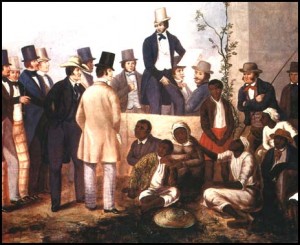
I’m Fonda Of Your Panties, Knickerocker!
I found these fabulous panties, here, at A Slip Of A Girl: the Jane Fonda New Workout Inspired Panties, by Knickerocker.
Of George Eliot & Marilyn Monroe
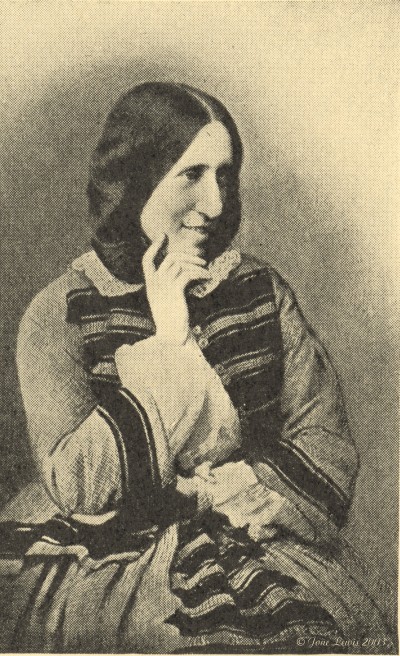
I am absolutely fascinated by Adair Jones‘s debate on the following question: “Was George Eliot’s late marriage a resignation from being a strong-minded woman?”
I haven’t read the works under discussion and, embarrassingly, my knowledge of George Eliot wouldn’t fill a thimble — but that doesn’t put an end to my opining. For it’s not the “did she or didn’t she” of the argument which has me most fascinated, but the “how” of it all…
Once there was a school of thought that held that autobiographies were superior to biographies; a person is the only one who really knows their own life, no amount of research can replace that. Along the way, the sub-genre of memoirs was created in order for a person to be able to tell a smaller story, the story of only a chapter or two in their lives as opposed to the whole story. Memoirs were greatly discredited in the whole Oprah-Frey fiasco. None of that memoirs stuff is of importance here; but memory is.
You see, I don’t remember things by dates. I have a linear concept of time, but dates are not my thing. And time itself passes unevenly for me — for most of us. My children, for example, grew up overnight despite those sleepless nights which I thought would never end. Time waiting for a child in a counseling appointment without a book vs. the same one hour appointment with a book, well, you know how that goes. And then there’s the matter of memory…
What I remember and what my husband remembers about things we’ve done, conversations held, etc. clearly exposes problems with perceptions. What I consider significant, he may not; and vice versa. And I, like many people I am told, often walk to the kitchen only to wonder why I went there.
Memory is a twisty thing.
So how reliable am I in terms of writing my autobiography?
I’m guessing not good at all.
So would the biographer be better?
I swore I wrote about (some of) this before, but I write so many places that if I did, I couldn’t find it; if I do find it, I’ll update with a link. [Note to self: you’re loosing your mind.]
But that is, in part, precisely what I’m talking about. If I were writing my own biography or memoir, I might just reference something I believed I wrote. And even upon being unable to produce it, would swear it was misplaced (or, if I’d grow even more paranoid, claim it was stolen). I’m that convinced I did it. Even if I hadn’t included that tidbit in my autobiography, some researcher pouring through my personal effects, correspondence I’d written over the years, etc. might just find that I’d penned a letter in which I swore that I had written on the subject. Perhaps I’d even accuse a person of the theft of it. This poor researcher / author would then have proof of my presumption, but not what actually happened.
And this is only one example which is far more cut and dried than other realities… The article or written work exists or it doesn’t; my faulty memory may be found out due to evidence one way or another. But what of my motivations?
What if I insisted I wrote something, knowing I did not, but wished to claim the work of someone else? What if I hated someone so much I convinced myself the story was true, could even pass a lie detector test because I, in fact, believed what I was saying? Maybe I did believe it so much because I was unable to be truthful with myself about my own actions?
We all tell ourselves lies everyday. Just to get through the day. Most of them aren’t so big and bad as accusing someone of theft. We usually don’t lie to hurt others but rather to protect ourselves. We lie to ourselves about the deeper things we cannot face, little and big vanities alike.
Whatever George Eliot aka Mary Ann Evans aka Mary Anne Cross writes to her friends she is also writing to herself. She has her reasons as much as her denials to motivate her. And so, even a historian with access to public and private works, letters and diaries, is still limited by the memories and motivations of their subject.
Did Eliot consider her last marriage an act of dependence? An independent or vain act that would ensure her legacy? Was it just easier to count on someone in her old age, easier to tell people that, or what?
Who knows.
It’s intellectual fun to pluck at the strings left behind, like clues leading to the the ball of yarn that is a hero’s psyche. But we don’t know. We cannot read their soul.
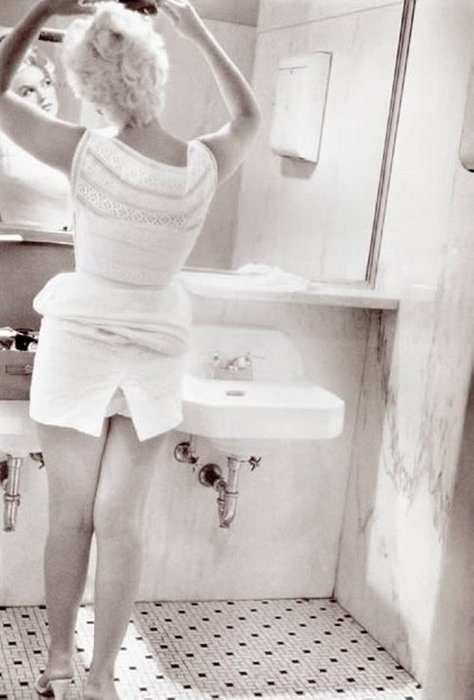
This is why we have so many biographies. Even after the memoirs and autobiographies (with and without the help of others), even after hundreds of other biographies, there’s still room for more.
Some people who count such things say there are 600 books on Marilyn Monroe alone — with new releases each year. Because she continues to fascinate me us. Forget the suicide-or-murder debate; forget the motivations, cover-ups, bungles, etc. of other people; we can never know what went on in Marilyn’s head or heart because no one, not even her contemporaries and confidants, knew that.
Marilyn and Mary Anne, and all the others, will continue to fascinate us because we will never ever know. We will never be truly sated by any “definitive” book on a person because we can never ever have the definitive answers.
Whatever the subjects of biographies and autobiographies leave for us, whatever they tell us, remains forever between the memory gaps, what they believed, the stories they’ve told themselves, what they believed they needed to protect when they told others their stories…
That is unsettling.
It’s a realization that we cannot ever really know anyone.
And so we continue to read, investigate, interpret, what we can. …Still hoping we will find The Truth.
Think Global, Act Local
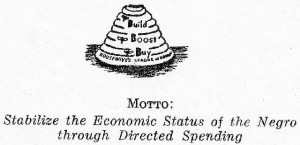
“Think Global, Act Local” is more than an old saying or mantra; it’s a philosophy. Thinking globally while acting locally is a way to take huge problems, like racism (as the image shows), and break them down into manageable, individual, acts. It motivates anyone who believes “If you’re not part of the solution, you’re part of the problem.”
I was reminded of this when Nazneen Hamilton wrote about the importance of buying locally produced items. It’s not only a wise thing to help your local economy — and generally helps your own household finances (something you know I care about) — but it also has a huge impact on the environment.
Heck, buying locally grown food and/or locally made products is a far greener thing to do than getting a newer less-gasoline-guzzling car or even getting one of those hybrid or electric cars — because the cars and batteries are brought over the oceans on freighters, freighters which leave far larger carbon footprints (or wakes) than most of us can imagine.
So I have to ask you, when’s the last time you checked the labels to see if you could buy local?
And, if you do and find your favorite shop doesn’t offer a local alternative, have you pushed them to do so?
Sexy Sanitary Belts?!
I can only tolerate so much. And “Vintage Sexy Women Sanitary belt Panties Lingerie” goes past that place.
Do you still remember the sanitary belt from last century, which was only used for women monthly period, now we have them in new design, some of them are with pure cotton material inside, some are made with rubber inside…. please see below for the difference
You can also put them on as sanitary belt by place sanitary pads on, but more important, they are new underwears making you sexier and more special. just image it!!
1. Condition:100% new, never been wron
2. Size: one size fits more with the straps
belt length:around 17.0″, width: around3.0″ .
3. Color: show as the picture.
4. Packing: simple plastic bag, then packed in dark grey bag when shipment is made to keep private.
Hey, these garments come from China, so I’ll excuse the English as a second language issues — but the garment itself? No way.
I realize there’s a sexual fetish about everything, including menstruation, but really, so in your face about it? Really?!
The old sanitary pads that were worn with sanitary belts were like bricks. I know. I’m old enough to have seen them. First, in that grade school girls only “changing bodies” talk in the gym. And, yup, those thick brick sanitary napkins were on store shelves too. Mom warned me about them, and I, when I reached that special time, opted for the modern marvel of sanitary pads which were both thinner and had adhesive on the underside so they stayed in place in your panties. Even then, I quickly switched sides and became a “cork girl.”
“Corks,” that’s what we called tampons around our house; it was corks or pads. No one opted for bricks, though I’m sure they were still available. On store shelves then too. After all, you can still find them today at hospitals and stuff, so someone is making them, selling them.
Now that I’ve already digressed…
Here’s a horrifying truth from my young womanhood: When my sister, mother, or I had “the curse,” we had to remove our sanitary paper product, wrap it thrice in toilet paper, place it neatly into a small paper lunch bag (kept in supply neatly in the cabinet under the bathroom sink), close the paper bag by folding down the top three times, then carry the whole thing out to the garage — immediately. How’s that for communicating the evils of bodily female functions?
One tradition I did not hand down to my daughters.
Anyway, back to the “sexy sanitary belts.” Elastic strips are not sexy, or comfortable. Hell, that’s why I hate thongs. Adding areas for storing menstrual flow is not sexy. I repeat: not sexy.
I’m not saying women should be ashamed of their monthly cycles (say by removing all signs of it from the household asap). Or that women should feel uncomfortable about using pads rather than corks (that’s just my personal preference). And yeah, you have my permission to love and lust the periods and products of your periods; to each their own includes kink and fetishes. But to market sanitary belts as sexy panties is to clearly not understand what is generally sexy, what the general human population will respond to as sexy, or why people would enjoy this particular kink.
The whole thing shows a lack of understanding about marketing as deep and vast as the complete lack of understanding of taboos as turn-ons.
That is unforgivable.
And the Christmas tree lights border around the whole page?! Oh, gawd, puh-leeze give me a toaster or appliance instead. I know that small appliances are no-nos as gifts for a woman, especially from her spouse or lover, but now that these “sexy sanitary belts” are an option… Well, honey, you have my permission to get me a toaster. No, make that a mixer; I do have a fetish for those.
However, you can buy these sexy sanitary belts for men and women here.
Suffering A Man In A Dress For Suffrage
On the front of this 5 3/4 X 3 1/2 “snapshot,” which the seller says is circa 1915, someone has printed “AN ARIZONA SUFFRAGETTE.”
As I cannot handle this photograph, I am not certain of it’s age — but I am certain that the “suffragette” it is a man wearing a dress and apron. Something about the photo feels more modern than 1915… Maybe it’s just that men putting on dresses to mock women for being too masculine to be pretty, that equal rights for women is as silly as a man wearing a dress, that the whole thing is just too-too familiar.
Archimedes Screw – You
One of my favorite altered art works; you can buy a poster copy, if’n ya wanna.
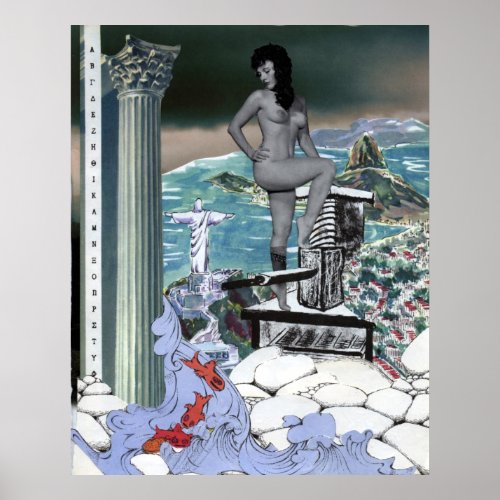
How To Dress For Success: Suffragette Edition
In The Washington Post, November 1, 1909, an unidentified “London fashion designer” gets bitchy and judgmental about how suffragettes dress. Yes, even though I don’t know if this possibly fictitious designer is male or female, I say “bitchy.” For even should ye olde fashion designer be both real and male (gay stereotypes aside), the fact that this item appeared at all in the Society pages, is proof of the bitch factor.
But perhaps most importantly are the number of appearances of myths, stereotypes, and general mean spiritedness which are preyed and played upon today:
The worst blow the cause of equal suffrage has received is the charge that its champions are careless in dress. Women who are not neat in attire and care nothing for personal adornment cannot hope to attract or influence men, and the future is gloomy for the British suffragettes at least. A London fashion designer has divided the suffragettes into four classes, each one marked by distinctiveness in dress.
“In the first is the woman of independent means,” says this fashion critic, “who can can and following her habit does dress well, and also the woman of limited income with an instinct for clothes Secondly, there is the working suffragette, who, as a rule, is a typewriter, and goes to the office in neat shirt waist and skirt She does not differ in any way from the woman clerk in any ordinary office, or the school teacher and secretary Thirdly we arrive at the thin, corsetless esthetic type, the modern development of the love-sick maiden who adorned Bunthorne These ‘willowy’ suffragettes adopt the empire and pinafore gown, with strange embroideries and sometimes strange results Last of all comes the suffragette who looks as though she had just returned from the wars and was still in fighting kit She generally wears a green costume of skimp design and rough material, a purple scarf, an impossible complexion, ‘something’ on her head and ‘something’ on her feet Few suffragettes have the faintest idea how to dress their hair Either they have not the time to spare from work for the great cause to give their hair ordinary care or attention, or else the languid drooping style and the straying wisps of hair are meant to illustrate the down-trodden station of women”
All of which should make the most ardent suffragette pause!
Do Women Have To Be Naked To Get Into U.S. Art Museums?
Made by the Guerrilla Girls; found at Experimentations Of A Teenage Feminist.
A Tube Top By Any Other Name…
Still drops and rolls just as horribly.
Sorry, folks, but this Hanky Panky Signature Lace Lined Bandeau Bra is really just a lace tube top. I know, I know, I’m a big-busted-biased woman who’s never liked tube tops due to the gravity of gravity, but come on — a $46-and-change pink lace tube top?! (Sale via Shop It To Me.)
Suffragette Soap Ad
This ad, for sale from MAINE-ARTEMIS, shows how products were marketed to suffragettes.
Enoch Morgan’s Sons Company ad for Sapolio cake soap:
A suffragette is Mrs. Brown
Who’s cleaning up in Spotless Town
When she discovers wrongs to write
The mails assist her in the fight
De=voted readers high and low
Are voting for
Sapolio
Vintage Gold Diggers, 1952
I’m sure this pair of vintage advertising pieces from/for the Hi-Shear Rivet Tool Company were intended to be humorous, in that oh-so-popular risque way of 1952; but I find them predictably insulting. It’s not that they’re nude — I collect vintage nudes and risque materials. Or even that “he” is allowed modesty while “she” wears the gloves and smile of a burlesque performer. (Frankly, as nearly every woman has noted in the Anthony Weiner affair, the less male genitalia seen the better.) But it’s what else is seen inside these “Top Secret” cards when they are open…
He has a number of dependents — dependents, not children; she has none.
He has a payday; she has none.
He has a car; she has none.
He has a hobby; she has a pastime — with places to check “yes” or “no”?!
*sigh*
Maybe women wouldn’t be seen as gold diggers if they had the opportunity to earn their own paychecks, own their own cars, not be seen as dependent children… Have a legitimate hobby even.
Both vintage pieces from the collection of Jim Linderman.
